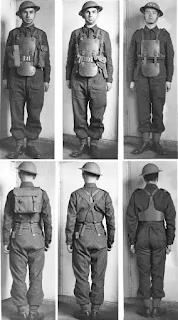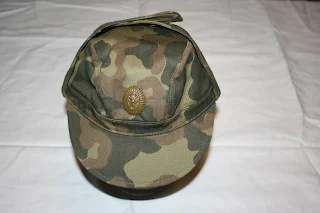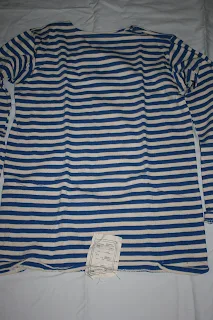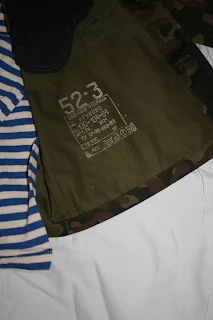One of the more esoteric and rare pieces of WWII British militaria is a piece of equipment called MRC Body Armour. It is comprised of three pieces of 1mm thick manganese steel (same as used in helmets) plate which are padded with heavy felt pads, each then sewn into a khaki light web/canvas covering, and fastened together by a series of riveted web straps with adjustable brass buckles, and a pair of brass hooks and elongated steel flat loops. The total assembly weighing 3 1/2 pounds.
In April 1942, the Military Research Council gave the go-ahead for standardizing personal protective equipment and beginning their mass production with a forecast of 3.5 million. Eventually, 200,000 sets of Briggs Bodies Motors (major manufacturer of the British Parachutist helmet (HSAT) and Harrison & Bros Howsons were produced by 1944, but only 79,000 were actually used and distributed among the army (3,100 for the Canadian Armed Forces, 6,000 for the paratroopers, for the SAS 400, for the Polish paratroopers 2500 ) And the Royal Air Force.
The author is not certain regarding the specific origin of the example which will be presented in this article. It is either very early British production for the British forces during WWII (See the following image; HQ, 56th Div., 11 Corps, Eastern Command, taken on 21 March 1942), or the known immediate post war production for the Belgian military forces (country or manufacturer unknown). Two principle indicators are the light green drab hue, compared with a lighter tan khaki of the vast majority of WWII British web equipment, and the fact that someone has seen fit to obscure a marking on the under side of the center plate, for one reason or another. Another indication is that the assembly and stitching of the cloth material in each of the three plates does not seem to come up to the normal quality control expected of either British or Canadian manufacture. While most fittings, including rivets, are brass, there is an exception in that the small plates attaching the webbed straps to each of the three plates, and the two elongated slot fittings, brass riveted to the lower corners of the front center rectangular plate appear to be steel. This detail is consistent with all British production. One thing for certain it is not a replica. The image of a known reproduction by Kay Canvas is shown further below for contrast/comparison.
Unfortunately there is a paucity of surviving examples outside of museums and private collections to compare with. However, given a comparison with all the details of known British manufactured examples, strongly indicates this specimen is also of British manufacture. One of the singular documented use of MRC Body Armour in combat action, is by the British and Polish Airborne Forces during Operation ‘Market - Garden’. There is a specific classic photograph of a group of Polish doctors in battledress, surgical aprons, and MRC body armour, in a forward Field Ambulance Unit aid station. Another unit that was known to have used the armour were members of the Glider Pilot Regiment. One of the main reasons for the rarity of historical photographic evidence, is that the prescribed way of wearing the equipment, is strapped on the inside of an individual’s battledress uniform. The MRC armour was found to be uncomfortable to wear, consequently not widely used.
The first image to be presented is an example on display, formerly at the Airborne Forces Museum at Altershot, Hants. Note that it is displayed on a Glider Pilot Regiment battledress blouse.
Another source, in a different view, attributes the same display after having been moved to the Airborne Assault Museum, Duxford.
A different set of MRC body armour on another battledress blouse at the Airborne Assault Museum at Duxford. Note you don't see the 1st glider pilot's brevet on the battledress.
This is followed by the museum's display of another set with a group of distinguished decorations (DSO w/bar, MC, and campaign medals) along with a Denison smock and maroon beret. After protracted observation under magnification the cap badge on the beret can be tentatively identified as Royal Army Medical Corps (brass, correct basic shape, k.c.). With both acknowledgment and gratitude to Ben Hill, ParaData Manager, Airborne Assault Museum, the Denison and MRC armour belonged to a sapper, i.e. (RE, REME), named Denning, and the group of decorations and medals are those of LtCol. Richard T.H. "Dickie" Lonsdale, DSO w/bar, MC, of Lonsdale Force, Oosterbeek, Operation 'Market-Garden'.
Unfortunately the next set of images does not have source attribution other than from an author's personal collection, however comes from a web site with an extensive discussion of the use of MRC body armour by Canadian military forces during WWII.
Following two images are an original and a reconstruction of the MRC body armour as employed by the Canadian Army during WWII.
The next example is an acknowledged currently produced replica set, clearly marked by the manufacturer Kay Canvas.
The following set of images is from this author's personal collection (found at the Great Western Gun Show in Pomona, Ca. in 1998), clearly showing a discernible difference in the color, as well as a certain wanting in manufacturing quality control. The flatness of all the plates as issued would indicate a large size (not known whether armour was issued in sizes). This has been corrected as seen in this photography, successfully flexed to the correct curvature.The author would be most appreciative of any reader's further insight regarding the origin of the armour.
The three components, front and back, of the author's example of MRC body armour with the steel plates having been correctly contoured to their intended curvature (no small task if done right). With the plates curved, the armour seems to be rather small in size. This leads one to believe that the obliteration of a marking on the reverse side of the square plate may have been to conceal a small size marking, judging from the length of the straps.
Here are a final two examples, the first apparently being either white or "blancoed", and manufactured for the Belgian army for either a stretcher-bearer, or for use with a winter camouflaged uniform. Said to have been found 20 years ago in a scrapyard un-marked, at that time sold for the equivalent of $351.00 USD, and the other of unknown origin, of a very light grey hue of khaki tan.
The three components, front and back, of the author's example of MRC body armour with the steel plates having been correctly contoured to their intended curvature (no small task if done right). With the plates curved, the armour seems to be rather small in size. This leads one to believe that the obliteration of a marking on the reverse side of the square plate may have been to conceal a small size marking, judging from the length of the straps.





























































